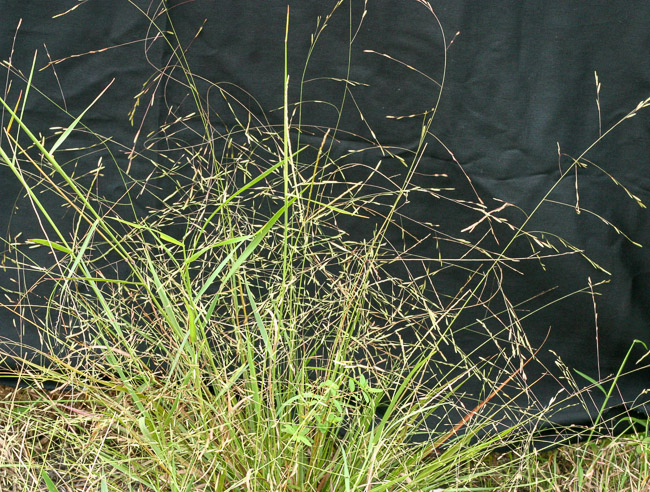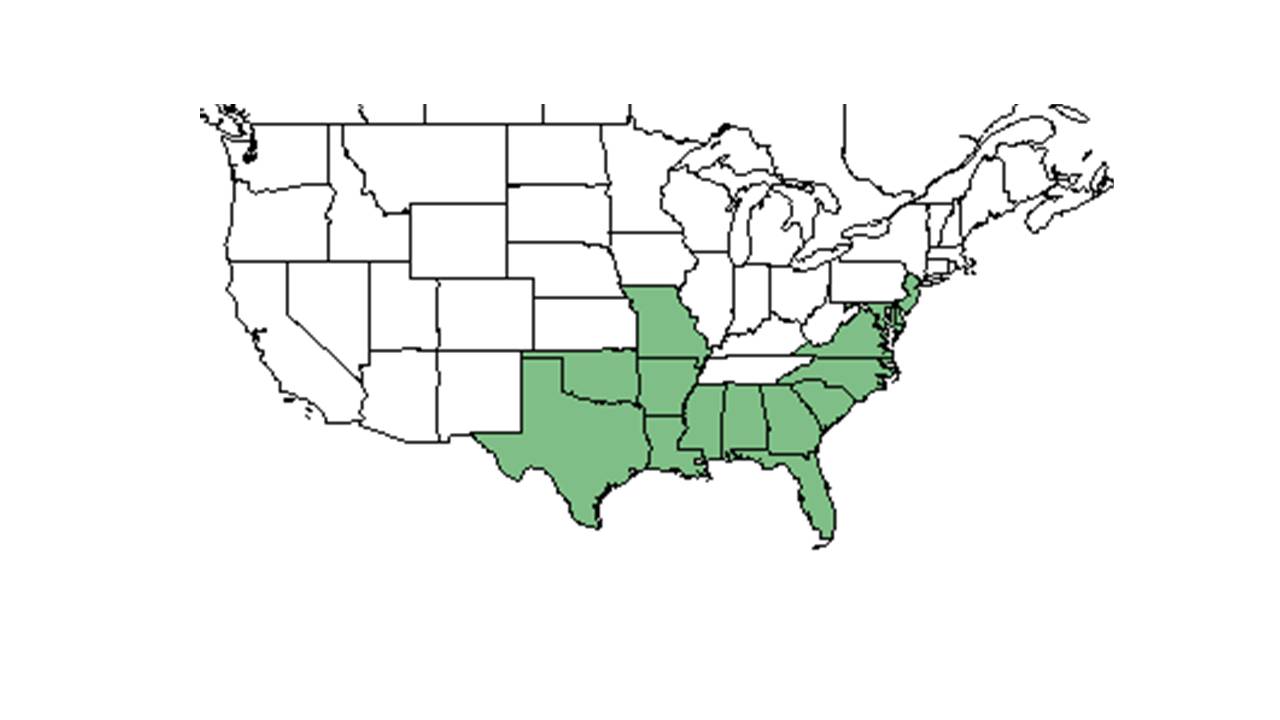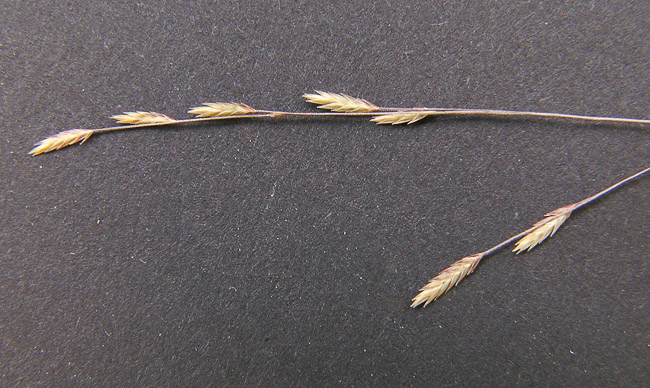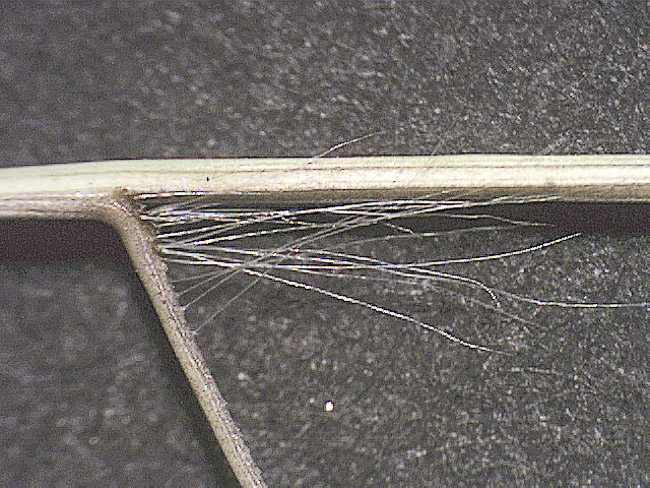Difference between revisions of "Eragrostis refracta"
(→Ecology) |
|||
| Line 34: | Line 34: | ||
==Ecology== | ==Ecology== | ||
===Habitat=== <!--Natural communities, human disturbed habitats, topography, hydrology, soils, light, fire regime requirements for removal of competition, etc.--> | ===Habitat=== <!--Natural communities, human disturbed habitats, topography, hydrology, soils, light, fire regime requirements for removal of competition, etc.--> | ||
| − | Is found in open longleaf pine woods, open woodlands.<ref name=fsu>Florida State University Robert K. Godfrey Herbarium database. URL: http://herbarium.bio.fsu.edu. Last accessed: June 2014. Collectors: Loran C. Anderson, J. M. Kane, Cindi Stewart, - MacClendons, and Annie Schmidt. States and Counties: Florida: Gadsden, Jackson, Liberty, and Suwannee. Georgia: Thomas.</ref> and in pineland, savannas, bogs and seeds, and marshes.<ref name=weakley/> Is also found along the roadside edges. Requires high light levels. Is associated with areas with dry sand or dry, loamy sand soil types.<ref name=fsu/> It is listed by the USDA Natural Resources Conservation Service as a facultative wetland species, where it most often occurs in wetland habitats, but can also occasionally be found in non-wetland habitats as well.<ref name= "USDA"/> | + | Is found in open longleaf pine woods, open woodlands.<ref name=fsu>Florida State University Robert K. Godfrey Herbarium database. URL: http://herbarium.bio.fsu.edu. Last accessed: June 2014. Collectors: Loran C. Anderson, J. M. Kane, Cindi Stewart, - MacClendons, and Annie Schmidt. States and Counties: Florida: Gadsden, Jackson, Liberty, and Suwannee. Georgia: Thomas.</ref> and in pineland, savannas, bogs and seeds, and marshes.<ref name=weakley/> Is also found along the roadside edges. Requires high light levels. Is associated with areas with dry sand or dry, loamy sand soil types.<ref name=fsu/> As well, a study found this species to increase in frequency when disturbance, like clearcutting, was conducted in the community.<ref>Brockway, D. G. and C. E. Lewis (2003). "Influence of deer, cattle grazing and timber harvest on plant species diversity in a longleaf pine bluestem ecosystem." Forest Ecology and Management 175: 49-69.</ref> It is listed by the USDA Natural Resources Conservation Service as a facultative wetland species, where it most often occurs in wetland habitats, but can also occasionally be found in non-wetland habitats as well.<ref name= "USDA"/> |
Associated species include Composites, legumes, and grasses. Also ''Eriocaulon lineare'' and ''Lachnocaulon minus.''<ref name=fsu/> | Associated species include Composites, legumes, and grasses. Also ''Eriocaulon lineare'' and ''Lachnocaulon minus.''<ref name=fsu/> | ||
Revision as of 14:57, 8 May 2019
| Eragrostis refracta | |
|---|---|

| |
| Photo and permission granted by George Rogers and John Bradford, Florida Grasses.org | |
| Scientific classification | |
| Kingdom: | Plantae |
| Division: | Magnoliophyta - Flowering plants |
| Class: | Liliopsida – Monocotyledons |
| Order: | Poales |
| Family: | Poaceae ⁄ Gramineae |
| Genus: | Eragrostis |
| Species: | E. refracta |
| Binomial name | |
| Eragrostis refracta (Muhl.) Scribn. | |

| |
| Natural range of Eragrostis refracta from USDA NRCS Plants Database. | |
Common name: Coastal lovegrass
Contents
[hide]Taxonomic notes
Synonym: Eragrostis virginica (Zuccagni) Steudel
Description
Weakley states that some authors have taken up the older name E. virginica, as a synonym for E. refracta, but the application of synonymy is uncertain.[1]
Generally, for the Eragrostis genus, they are "annuals or perennials from short rhizomes or hardened bases. Glumes similar, shorter than lowest lemma. Florets more than 2. Lemmas 3-nerved, paleas persistent, ciliate."[2]
Specifically, for Eragrostis refracta species, they are "cespitose perennial from hardened base; culms 3-10 dm tall, nodes and internodes glabrous. Leaves primarily low cauline; blades elongate, to 2.5 dm long, 1.5-4 mm wide, pilose above, glabrous beneath, margins scaberulous; sheaths glabrous; ligules membranous, 0.1-0.2 mm long, long trichomes in throat. Panicle loose, open ½-3/4 height of the plant, ½ to as broad as long; branches flexuous, scaberulous. Spikelets with dark margins and light centers, 4-22 flowered, lateral spikelets longer than pedicels, appressed, 8-13 mm long, 1.5-1.8 mm wide. Glumes 1-nerved, scabrous keeled, acuminate, 1st glume 0,8-1.3 mm long, 2nd glume 1.5-2 mm long; lemmas scabrous keeled, acuminate, 1.5-1.8 mm long; paleas 1-1.5 mm long. Grain reddish, oblong, 0.5-0.7 mm long."[2]
Distribution
It is distributed from Deleware south to Florida, and west to Texas.[1]
Ecology
Habitat
Is found in open longleaf pine woods, open woodlands.[3] and in pineland, savannas, bogs and seeds, and marshes.[1] Is also found along the roadside edges. Requires high light levels. Is associated with areas with dry sand or dry, loamy sand soil types.[3] As well, a study found this species to increase in frequency when disturbance, like clearcutting, was conducted in the community.[4] It is listed by the USDA Natural Resources Conservation Service as a facultative wetland species, where it most often occurs in wetland habitats, but can also occasionally be found in non-wetland habitats as well.[5]
Associated species include Composites, legumes, and grasses. Also Eriocaulon lineare and Lachnocaulon minus.[3]
Phenology
Generally, E. refracta flowers from July until October.[1] This species has been observed to flower and fruit from September to November.[3]
Pollination
This species pollinates by hydrophilly, where pollen is dispersed by waterflow in rivers and streams.[6]
Conservation and management
E. refracta is listed as threatened by the Maryland Department of Natural Resources, Natural Heritage Program.[5]
Cultivation and restoration
Photo Gallery
Seedhead of Eragrostis refracta Photo and permission granted by George Rogers and John Bradford, Florida Grasses.org
Spikes of Eragrostis refracta Photo and permission granted by George Rogers and John Bradford, Florida Grasses.org
References and notes
- ↑ Jump up to: 1.0 1.1 1.2 1.3 Weakley, Alan S. Flora of the Southern and Mid-Atlantic States: Working Draft of 21 May 2015. University of North Carolina Herbarium (NCU). PDF. 406.
- ↑ Jump up to: 2.0 2.1 Radford, Albert E., Harry E. Ahles, and C. Ritchie Bell. Manual of the Vascular Flora of the Carolinas. 1964, 1968. The University of North Carolina Press. 66-71. Print.
- ↑ Jump up to: 3.0 3.1 3.2 3.3 Florida State University Robert K. Godfrey Herbarium database. URL: http://herbarium.bio.fsu.edu. Last accessed: June 2014. Collectors: Loran C. Anderson, J. M. Kane, Cindi Stewart, - MacClendons, and Annie Schmidt. States and Counties: Florida: Gadsden, Jackson, Liberty, and Suwannee. Georgia: Thomas.
- Jump up ↑ Brockway, D. G. and C. E. Lewis (2003). "Influence of deer, cattle grazing and timber harvest on plant species diversity in a longleaf pine bluestem ecosystem." Forest Ecology and Management 175: 49-69.
- ↑ Jump up to: 5.0 5.1 USDA, NRCS. (2016). The PLANTS Database (http://plants.usda.gov, 8 May 2019). National Plant Data Team, Greensboro, NC 27401-4901 USA.
- Jump up ↑ Koch, S. D. (1978). "Notes on the genus Eragrostis (Gramineae) in the southeastern United States." Rhodora 80: 390-403.

